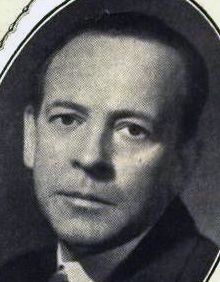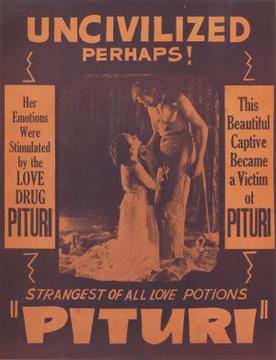
Jedda, released in the UK as Jedda the Uncivilised, is a 1955 Australian film written, produced and directed by Charles Chauvel. His last film, it is notable for being the first to star two Aboriginal actors, Robert Tudawali and Ngarla Kunoth in the leading roles. It was also the first Australian feature film to be shot in colour.

Charles Edward Chauvel OBE was an Australian filmmaker, producer and screenwriter and nephew of Australian army General Sir Harry Chauvel. He is noted for writing and directing the films Forty Thousand Horsemen in 1940 and Jedda in 1955. His wife, Elsa Chauvel, was a frequent collaborator on his filmmaking projects.

In the Wake of the Bounty (1933) is an Australian film directed by Charles Chauvel about the 1789 Mutiny on the Bounty. It is notable as the screen debut of Errol Flynn, playing Fletcher Christian. The film preceded MGM's more famous Mutiny on the Bounty, starring Charles Laughton and Clark Gable, by two years.

Mary Maguire was an Australian-born actress who briefly became a Hollywood and British film star in the late 1930s.

Emily Hood Westacott, was an Australian female tennis player in the 1930s.

Forty Thousand Horsemen is a 1940 Australian war film directed by Charles Chauvel. The film tells the story of the Australian Light Horse which operated in the desert at the Sinai and Palestine campaign during World War I. It follows the adventures of three rowdy heroes in fighting and romance. The film culminates at the Battle of Beersheba which is reputedly "the last successful cavalry charge in history". The film was clearly a propaganda weapon, to aid in recruitment and lift the pride of Australians at home during World War II. It was one of the most successful Australian movies of its day. It was later remade in 1987 as The Lighthorsemen.
Sons of Matthew is a 1949 Australian film directed and produced and co-written by Charles Chauvel. The film was shot in 1947 on location in Queensland, Australia, and the studio sequences in Sydney. Sons of Matthew took 18 months to complete, but it was a great success with Australian audiences when it finally opened in December 1949.

The Broken Melody is a 1938 Australian drama film directed by Ken G. Hall and starring Lloyd Hughes, based on a best-selling novel by F. J. Thwaites.

Frank Harvey was a British-born actor, producer, and writer, best known for his work in Australia.

Uncivilised is a 1936 Australian film directed by Charles Chauvel. It was an attempt by Chauvel to make a more obviously commercial film, and was clearly influenced by Tarzan.

Robbery Under Arms is a 1920 Australian film directed by Kenneth Brampton and financed by mining magnate Pearson Tewksbury. It is an early example of the "Meat pie Western".

The Flying Doctor is a 1936 Australian-British drama film directed by Miles Mander and starring Charles Farrell, Mary Maguire and James Raglan. The Royal Flying Doctor Service of Australia operate in the Australian Outback. Noted as Australia's first "sound" feature film, The Flying Doctor was also the country's first feature-length film based on aviation.

Elsa Chauvel, was an Australian filmmaker and actress, and the wife and collaborator of film director Charles Chauvel. Elsa Chauvel was a pioneer in Australian film making, best known for her contributions to films such as Greenhide, In the Wake of the Bounty, and Jedda. Her legacy in Australian film was celebrated with the creation of the Chauvel Award, dedicated to the work of Elsa and Charles Chauvel, which honours Australian excellence in film.
Greenhide is a 1926 Australian film directed by Charles Chauvel. Only part of the film survives.
The Moth of Moonbi is a 1926 Australian film directed by Charles Chauvel. It was adapted from The Wild Moth, a 1924 novel by Australian author Mabel Forrest. It was Queensland's first feature length film
The Squatter's Daughter is a 1933 Australian melodrama directed by Ken G. Hall and starring Jocelyn Howarth. One of the most popular Australian films of the 1930s, it is based on a 1907 play by Bert Bailey and Edmund Duggan which had been previously adapted to the screen in 1910.
The Silence of Dean Maitland is a 1934 Australian film directed by Ken G. Hall, and based on Maxwell Gray's 1886 novel of the same name. It was one of the most popular Australian films of the 1930s.
Edward Vivian Timms (1895–1960), better known as E. V. Timms, was an Australian novelist and screenwriter. He was injured serving in the Gallipoli Campaign during World War I and was an unsuccessful soldier settler before turning to writing. He became a popular novelist, and also wrote scripts for films and radio. He served as an officer during World War II and was on duty the night of the Cowra breakout. He has been called "Australia's greatest historical novelist."
Clara Gibbings is a 1934 Australian film directed by F.W. Thring about the owner of a London pub who discovers she is the daughter of an earl. It was a vehicle for stage star Dorothy Brunton.
Ethel Morrison, nicknamed "Morry" or "Molly" and described as a "large lady with a large voice", was a contralto singer from New Zealand who began her career in Gilbert and Sullivan operas and Edwardian musical comedies in England. She later acted mostly in Australia and was noted for her performances in domineering roles.














